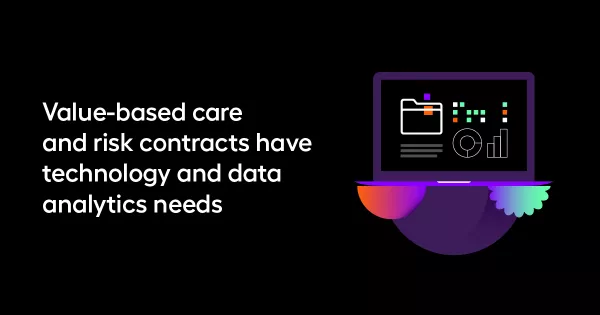Value-based care and fully delegated risk: Which model is right for your healthcare organization?
Value-based care is an effort that has been building for 50 years. The precursor to value-based care (VBC) was the HMO Act of 1973. The idea was to improve health, decrease healthcare costs, and increase preventative healthcare. Insurance companies jumped into the game and new companies formed, but by the 1990s, the industry was seeing the failure of about 50% of everyone who was taking on risk. In fact, the LA Times reported in 1999 that 20 major hospital management firms, HMOs, and large physician organizations had gone bankrupt in the previous year.
In the 2000s, everyone in most states went back to a fee-for-service model. In 2010, nearly 40 years after the HMO Act, the Affordable Care Act (ACA) was passed with the goals to improve healthcare, decrease costs, and increase preventative healthcare. It brought different ideas about how to make that happen — Accountable Care Organizations (ACOs) — which turned into value-based care as we know it today.
Many organizations have reached a point where they feel they must move from fee-for-service to risk and have questions as to the best ways to get there. Brian Croegaert, Senior Vice President of Value-Based Care at Arcadia, Carrie Nave, Director of Operations at Ascension; and Nicole Geier, Director of Client Business Management at Arcadia discussed the hows and whys of taking on risk in today’s environment during a recent Arcadia webinar, Moving to value-based care: From risky business to data-backed decisions.

Defining risk and identifying types of contract options
Figuring out an organization’s approach begins with defining risk and identifying the types of contract options available.
“When you start getting into risk, you have to understand the market, you have to understand where you are at,” explained Nave. “Are you at fee-for-service in your area? Are you in value-based in your contracts? Or are you actually in risk?”
She adds that you need to know where the payers are going and understand where your provider base is in your market.
From there, organizations can explore different types of contracts and compare them to how much staff and resources they have to deliver on the contract. There are two major models: risk agreements and value-based agreements. Risk agreements are full risk contracts where the organization takes on all of the risk. In value-based agreements, the insurance company pays the claims and the health system handles the quality measures and metrics.

What healthcare systems who take on risk need to be successful
Getting into fully-delegated risk is similar to setting up an insurance company. Acting as an insurance company is very complex, so start by acknowledging what you can do yourself (often, patient engagement and provider engagement) and understanding the options for outsourcing (larger organizations utilize analytics reporting, quality scores and high risk member identification, while smaller organizations utilize claims processing, utilization management, quality and care management and customer service).
“For example, if you can’t pay your claims, but you want to do your quality, and you have nurses who can do care coordination, and you have provider relations people who can contract with your providers and do the credentialing, then that’s what you can use Arcadia to do,” said Geier. “Arcadia can focus on the complexities of paying claims and managing the provider fee schedules and doing the provider adds and deletes and all of the administrative stuff that comes along with risk contracts.”
And remember, healthcare organizations don’t need to take on fully-delegated risk. Value-based care and measuring quality metrics to close gaps is a good stepping stone.

Value-based care and risk contracts have technology and data analytics needs
As healthcare organizations enter into value-based care and risk contracts, they need the right technology tools and data analytics tools to make critical decisions. This data is used in a myriad of ways.
“At Arcadia, we’re collecting data through connectors from a little bit more than 30 different kinds of EMRs along with all the claims data that gets developed and sent to us on behalf of the providers,” said Croegaert. “All of that gets run through our analytics tools to be able to publish that information back to doctors who can use it to make the appropriate decisions.”
Beyond data-driven decision making, organizations can use the data to show what quality outcomes their providers have in order to negotiate better contracts with the payers.
“If you have a large membership, you’re keeping your quality scores up, your patients are generally healthy, they’re getting their preventative services or if you have a sick population, and you can prove that your risk scores are high, but you’re still managing the members very well, you can use that data to then get better value based care contracts,” said Geier.
Organizations can also use data to engage and empower providers through provider outreach. With PCP scorecards, you can track and share quality measures with providers. This helps close gaps, increase patient engagement and keep members in-network.
“We show providers their PCP report card quarterly so they’re able to see their quality measures where they need to close their gaps where they’ve done a really good job,” explained Nave. “We also let them see and compare themselves with the other primary care physicians in our network.”
She continued, “We have the PCP scorecards which show in- and out-of-network in terms of where their patients are going—with the risk product, it’s really important to keep the members in network—so we share that data with the physicians.”
Ascension uses its own provider relations team to go out to the provider offices to provide coaching, training, and re-education.
Knowing whether to build or buy data analytics tools is a conundrum that often develops as well, especially as healthcare organizations grow. The build or buy framework can guide you through the decision-making process and help your organization decide what is right for it — we examined the arguments from the leadership team as well.

Moving forward with taking on risk
While transitioning to value-based care is complex, it’s not unattainable and thrives on efficiency. Strong data and data analytics make that efficiency possible. Watch the full webinar and reach out to Arcadia to learn more about its value-based-care services.
